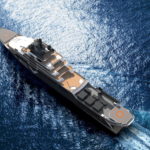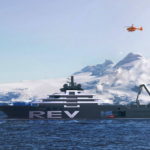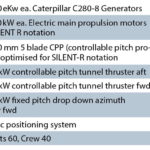Norway’s Vard shipyard continues to diversify its orderbook. For the project »Rosellinis Four-10« a new research expedition vessel is[ds_preview] being built until 2020. It will feature the VARD 6 16 design that was developed for navigating in the most challenging and vulnerable environments, from arctic to tropical areas. With a length of 182 m, the vessel will be the longest unit ever designed and built by Vard.
The DNV GL classed vessel is designed with slim hull lines in combination with wave-cutting bulb, slender foreship, large propellers and two pairs of stabilization fins. Other key features are the energy recovery rudder system, medium-speed engines, a direct drive diesel-electric propulsion system with battery package, and an exhaust cleaning system.
The vessel will also employ SeaQ Green Pilot, developed by Vard Electro, a data driven maritime energy management and operational performance system. By using real-time measurements, mathematical models and analysis of the vessel’s performance, an expert system will give the operator advice on the ship’s performance and fuel consumption. This will empower the crew to minimize the carbon footprint of the vessel.
The research and expedition area features modern laboratories, an auditorium, a hangar for a Remote Operated Vehicle (ROV) and an Autonomous Underwater Vehicle (AUV) with direct access to the vessel’s moonpool, and a multifunctional cargo deck.
Vard’s subsidiary Seaonics has developed a scientific winch package for handling through moonpool and over side, a 20t fibre rope crane with reach down to 6,000m, and a pelagic trawl setup with catch selection for operations down to 3,000m depth. All operations including trawling will be inside operations either from the hangar amidships or from a horizontal built in A-frame construction at the stern.
The hull will be built at Vard Tulcea in Romania, outfitting will be carried out by Vard Brattvaag in Norway. After delivery in Norway, the vessel will return to Romania for fairing, deck laying and finalization of the accommodation area.
The project is wholly owned by the Norwegian industrialist Kjell Inge Røkke and his family. The vessel is planned for worldwide research and expedition activities, with the objective of developing knowledge and sustainable solutions to address the ocean’s environmental challenges. WWF Norway is invited by the shipowner to take part in the further development of the research and expedition project.




















